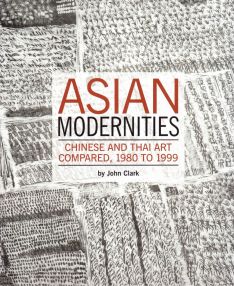
2019
SPECIAL PROJECTS
What, exactly, is a “knowledge platform?”
From the moment of its founding in January 2010, THAI ART ARCHIVES has pursued a comprehensive mission. This mission acknowledges how in any attempt to recollect the past—or even to thoughtfully reflect on the present—we are bound to gain new insights into an artist’s creative processes, the complexities of an artistic movement, or the wider cultural ramifications of any given moment in history. New insights, whether they be panoramic and paradigm-changing, or merely partial glimpses, warrant public attention. Just as important, they deserve to be integrated into regional and global histories. If there are, in fact, many “moderns” around the globe—as John Clark has persuasively argued in Asian Modernities [Power Publications, 2010]—a well-reasoned global history will accord each one its full due, thereby acting as a valuable corrective for otherwise persistent Euramerican biases.
In this spirit, the THAI ART ARCHIVES aims to study collections comprehensively, in hopes of contributing new knowledge to our understanding of Thai modern and contemporary art and the full nature of its heritage for future generations. Every era in history has its own “Thai contemporary”; just as important, every era in history has multiple definitions of the "modern" vying for a place in collective memory. Ancient and pre-modern subjects continue to win attention from archeological and antiquarian societies (as in the case of monument restoration and conservation, or heritage-site administration); similarly, the Thai modern and contemporary avant-garde begs a more thorough curatorial and scholarly attention.
The TAA as “knowledge platform” therefore makes the studying and researching of collections---as well as the locating, exhibiting, and preserving them---a high priority. To remain true to that ideal, we conceive of topics in the manner of great museum exhibitions, stimulating symposia, and lively seminars. We carry out research in collaboration with the world’s finest colleagues. And we emphasize providing students and scholars with first-rate, hands-on experience with "international-standard" archival and museum projects. Our ideals include pushing research towards publishing and exhibitions featuring recent findings, all towards the ideal of adding new, concrete knowledge to our understanding and appreciation of recent history.
[Photo: John Clark, Asian Modernities: Chinese and Thai Art Compared, 1980 to 1999 (2010; Power Publications, Power Institute Foundation for Art and Visual Culture, University of Sydney); by kind permission of the author and publisher; ALL RIGHTS RESERVED. John Clark is an Advisory Board Member of Thai Art Archives.]
Internships/Fellowships
FOR EACH OF THE PROJECTS LISTED BELOW, COURSE CREDIT FOR INDEPENDENT STUDY MAY BE AVAILABLE TO STUDENTS CURRENTLY ENROLLED IN A DEGREE PROGRAM. SOME PROJECTS MAY HAVE THE POTENTIAL FOR OFFERING POST-GRADUATE FELLOWSHIPS (i.e. paid part-time assistance). Please contact us for further information.
Current Projects
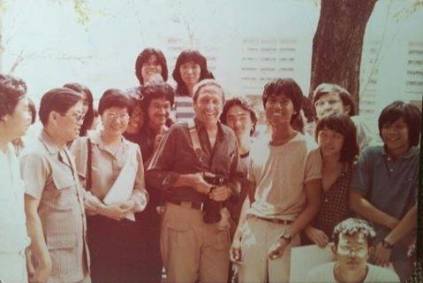
March 2016
ROBERT RAUSCHENBERG AND THE RISE OF A "THAI CONTEMPORARY," 1964-1984
The Robert Rauschenberg and the Rise of a "Thai Contemporary," 1964–1984 [working title] research project/exhibition seeks to comprehensively document Robert Rauschenberg’s 1964 and 1983 tours of Thailand, and investigate aspects of artistic influence and the rise of a "Thai contemporary" by recovering a host of currently “lost” or unseen materials in Thailand, as well as by uncovering new, never-before-seen or studied documentary and archival materials in the Robert Rauschenberg Foundation collections.
UPDATE AUGUST 2020 ******************************************
Due to TAA's inability to find a host institution, to date, for an originally planned exhibition, this project is currently slated to be written up as a scholarly article and published in 2021. Please stay tuned for updates by late 2020.
*******************************************************************************
By bringing together both Thailand-based oral histories, printed matter, photography, newspaper accounts, and other ephemera, with New York-based archival and documentary materials; and by bringing together completed art works on the theme of Rauschenberg’s Thailand tours, the THAI ART ARCHIVES seeks to demonstrate the importance of these tours for Rauchenberg’s evolving philosophy and artistic practice of cultural exchange and “mutual understanding,” indeed as he would articulate to the United Nations in 1984. This project thus aims to recover a lost chapter in the modernist art history of Thailand itself, as well as in the Rauschenberg literature documenting the evolution of his early work and the late work and agenda of ROCI, i.e. from the mid-1960s through the mid-1980s.
This project aims to culminate in the recovery and exhibition of never-before-seen or understood archival ephemera and art works both from Thailand and the United States, thus shedding new light on Rauschenberg’s Asian initiatives at a moment of great creative ferment not only in the United States, but in Southeast Asia itself. A conceptual springboard is Alexandra Munroe’s The Third Mind: American Artists Contemplate Asia, 1860–1989 (2009); in addition, we are referencing Hiroko Ikegami's, The Great Migrator: Robert Rauschenberg and the Global Rise of American Art (2010), as well as new historical reconsiderations of the careers of John Cage, Jasper Johns, and Merce Cunningham.
Resident Graduate Researchers: Napat (Mai) Charitbutra, Silpakorn University; others in development.
Advisory Curators: Hiroko Ikegami, author of The Great Migrator: Robert Rauschenberg and the Global Rise of American Art (The MIT Press, 2010); Abigail Sebaly, independent researcher and former Rauschenberg archival fellow at the Walker Art Center.
With books generously contributed by The MIT Press.
[Photo above: Robert Rauschenberg visiting the campus of Silpakorn University, Bangkok, March 1983; Thai Art Archives; All rights reserved]
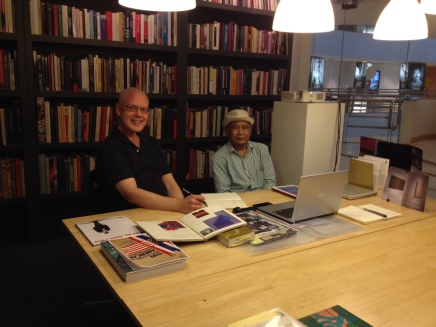
TAA Director Gregory Galligan interviewing Thai artist Pricha Arjunka [20 Aug 2014] on his memories of the visit of Robert Rauschenberg to Thailand in 1983. With a special thanks to Alfred Pawlin for introductions [photo by Thai Art Archives; All rights reserved].
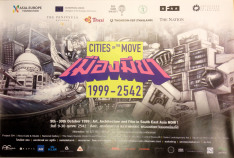
CITIES ON THE MOVE 6, Bangkok (1999)
CITIES ON THE MOVE 6 (1999, Bangkok) was one of the most important and groundbeaking exhibitions in recent history, but at present very little documentation is available to the public.
Over 2014-2015, TAA is sponsoring a special research project in cooperation with Cities co-curators HANS ULRICH OBRIST (currently Co-Director of Exhibitions and Programmes & Director of International Projects, Serpentine Gallery, London), HOU HANRU (Artistic Director, MAXXI, Rome) and OLE SCHEEREN (Büro Ole Scheeren, Beijing) to bring this history to light and create a dedicated research archives at our special projects hub at Bangkok Art and Culture Centre. This project was inspired by a conversation between Prof. Bruce Altshuler, Director of the Museum Studies program at New York University, and TAA director Gregory Galligan in 2013. Dr. Altshuler has recently published on Cities in his book, Biennials and Beyond: Exhibitions that Made History, 1962-2002 (Phaidon, 2013). As Prof. Altshuler explained in conversation with Gregory Galligan in New York, he originally wanted to write on the Bangkok iteration of Cities, but he chose its debut in Vienna for lack of materials available to the public on the concluding installation of this historic traveling exhibition in Bangkok.
Thai Art Archives will seek to recover as much ephemera from this show in Bangkok from the collaborating curators and original participants, the media, and others, and digitize this materials for public access. The project may culminate in a traveling exhibition and publication dedicated to the Bangkok iteration of Cities in 1999. Already generously contributing to this project are several former Cities 6 participants, among them Edouard Mornaud and Francine Meoule. If you participated in this show, or have materials related to it, please be in touch with TAA at thaiartarchives@gmail.com. We will aim to borrow and digitize much material for access by current and future generations.
Stay tuned for related announcements in the months to come!
With special donations of books by PHAIDON Press Limited.
[Photo: Cities on the Move 6,Official Poster, 1999/2542; by kind courtesy of Varsha Nair and the Womanifesto Archives; All rights reserved]
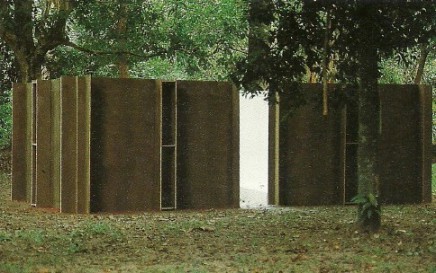
May 2014
CHIANG MAI SOCIAL INSTALLATION (CMSI): Art and Social Engagement in Thailand, 1992-Present
Since the early 1990s, the international contemporary art world has been dominated by the rise of relational aesthetics, a term denoting a new emphasis on audience participation, time-based projects, the impromptu happening, and even a new art practice of “social engagement.” Yet few observers are aware that Thailand was, and remains to the current day, a virtual incubator of the “relational” ideology, not only as it pertains to the work of its most internationally-celebrated artist, RIRKRIT TIRAVANIJA, but also to lesser-known collectives, such as the CHIANG MAI SOCIAL INSTALLATION (CMSI) project, which began in the northern city of Chiang Mai in 1992, and quickly came to define new currents in Thai participatory and socially engaged art throughout that decade.
SPECIAL UPDATE [AUGUST 2020]: While Thai Art Archives was the original party to publicly champion the importance of the CMSI to Thailand's contemporary art history, and while we were originally (as early as 2013) invited to document this history in collaboration with colleagues in Bangkok and Chiang Mai, the official archival work of CMSI has always been conducted by founding member Prof. Uthit Atimana, Chiang Mai University. Unbeknown to TAA, Professor Atimana was subsequently petitioned by others (in Thailand and abroad) to exhibit portions of his archives-in-development in overseas exhibitions in Gwangju (Asia Art Center) and Tokyo (Mori Art Museum). Subsequently, a regional symposium and a publication project transpired with AFTERALL publishers. At no point was TAA ever invited to participate in these developments; neither was TAA ever apprised of them or given credit for championing this archives in the first place. We simply state that fact here for the public record, as we've always championed policies of complete public transparency in the management of both TAA and its mission.
Thus we regret that TAA was categorically shut out from the project by late January of 2015, when we first learned of these developments. Nevertheless, we sincerely and heartily congratulate everyone involved with documenting this historic subject and bringing that research to fruition in an excellent book by Afterall (London). It goes to show what can be accomplished with the proper funding and concentrated effort.
For our own part, TAA continues to welcome related materials to unofficially complement these developments. Contact us at thaiartarchives@gmail.com for further information.
Photo: Chitti Kasemkittvatana, Mo(nu)ment to the 3rd Chiang Mai Social Installation, 1995-1996 [Installation, 3rd Chiang Mai Social Installation, 1995-1996]; by kind courtesy of the artist; All rights reserved.]

WOMANIFESTO: Art and Social Engagement in Thailand, 1990s-Present
"In 1995 a group of six Thai female artists met in Bangkok: Mink Noparat (the catalyst), Jittima Pholsawek (Ukabat group), Phaptawan Suwannakudt (art mural painter), Khaisaeng Phanyawatchira (performance aryist), Charassri Roopkamdee (printmaker), and Nitaya Ueareeworkul (artist). The result of the meeting was a painting, installation, and performance event called Tradisexion, emphasizing traditional conflicts stemming from being a woman. It was held at Concrete House (founded by Chumpoin Apisuk), celebrating World Women's Day (March 8th). The feedback was good, but the event had too small an impact as only artists attended: That was the starting point of the first and second WOMANIFESTO.
Studio Xang has always been the unofficial center for the art net-working and a meeting plavce for artists in Bangkok. The six artists continued to meet regularly at Studio Xang and eventually realized their plan for Womanifesto I. Baan Chao Phraya (Chaiyong Limtongkul Foundation) and Concrete House offered their premises. Thanks to the kind collaboration of Varsha Nair, and Indian artists residing in Baangkok, and Professor Somporn Rodboon of Silpakorn University, we were able to invite eighteen participating artists: Nine from Thailand and the remainder from Japan, Indonesia, India, Singapore, Pakistan, Austria, Italy, and the USA. Their work compried paintings, ceramic art, VDO-art, installation, and performance art. It was highly successful in many ways, particularly in establishing international networking among women artists."
—Excerpt from Womanifesto II: Second International Women's Art Exchange, exh. cat., Bangkok, 1999.—
By kind courtesy of Bangkok-based performance artist Varsha Nair, Thai Art Archives is currently working on the cataloging, studying, digitizing, preserving, and exhibiting of the extant archives of Womanifesto, one of Thailand's most groundbreaking artist collaboratives of the late 1990s to the present. Further announcements will be made in the months to come.
Current Assistant: Ashley Alexander, Curatorial Intern, 2016.
UPDATE AUGUST 2020
Thai Art Archives made it a priority from 2013-2018 to champion the WOMANIFESTO history and archives and take in Varsha Nair's materials when few others appreciated these materials' historic importance. Several TAA interns worked on Nair's archives from 2014-2016; the concept of exhibiting these materials in Bangkok was discussed; public outreach was conducted on our official website and social media pages; and studio visits were made by TAA director Gregory Galligan and, subsequently, an intern, before the archives was eventually returned to Varsha in March 2018 for safekeeping when it became clear that TAA could not keep its platform at BACC, and we were unable to raise necessary funding, despite many efforts (both regionally and internationally) to process Varsha's materials. We are deeply grateful to Varsha Nair for believing in TAA's mission back in 2013 and graciously allowing her archival materials to be part of our launch and development.
The WOMANIFESTO archives has subsequently been acquired by ASIA ART ARCHIVE (Hong Kong); all interested parties should visit the AAA website for further information.
[Photo Credit: Womanifesto III: Third International Women's Art Exchange, 2001, participating artists and volunteers; courtesy of WOMANIFESTO and participating artist Varsha Nair (pictured third from right), Womanifesto Archives, Bangkok; All rights reserved.]

ASIATOPIA: Durational, Performance, and Time-Based Art in Thailand, 1990s-Present
Harboring a “prehistory” in the happenings and time-based art of Europe and the United States of the 1960s and 1970s, DURATIONAL ART in Thailand has demonstrated a lively and sophisticated history from the mid 1990s to the present. Durational art originating in Thailand (no matter whether enacted in the region or overseas) demonstrates a wide range of motivations and forms of expression; often at once theatrical and intimate, it may engage social, political, and/or cultural themes or components that resonate far beyond Thailand’s own borders, often serving as a nexus for international collaboration, and a catalyst for social change and critique.
TAA's documentation efforts will initially focus on the major durational and performance-based artist collectives and their programs of the last twenty years. Most prominent among these collectives is ASIATOPIA, the annual international performance art festival founded in 1998 by Chumpon Apisuk.
Further announcements will be made in the months ahead as we discuss with these parties a plan for bringing together various forms of their histories and ephemera for enhanced public access and study.
[Picture Credit: Paisan Plienbangchang, Standing (Chumpon Apisuk in performance at Chiang Mai Papae Gate), ASIATOPIA, 2010; courtesy of the photographer and Asiatopia; All rights reserved.]

DO IT: THAI VERSION, BANGKOK (1996) Research/Documentation and New Installation, with Hans Ulrich Obrist and Independent Curators International (ICI)
By special invitation of Hans Ulrich Obrist and Independent Curators International (ICI), THAI ART ARCHIVES has been invited to host and coordinate a new iteration of DO IT in Bangkok, after the initial Bangkok show of 1996, which was coordinated by Chitti Kasemkitvatana, Surasi Kusolwong, and Edouard Mornaud.*
THAI ART ARCHIVES is launching a special archival documentation project on the original do it, Bangkok, in conjunction with our plans to host a new iteration of do it with a regional gallery (to be decided).
This project and exhibition also celebrate the recent publication of the archival history of do it by Hans Ulrich Obrist and Independent Curators International (ICI), an official partner of Thai Art Archives. The archival publication is available to the public for study at TAA's special projects hub at the Bangkok Art and Culture Centre, and it will be made available in quantity to the Thai public on the debut of the show in late 2015. (It may currently be acquired from DAP, Distributed Art Publishers; for further information, see http://www.artbook.com/dap.html).
Stay tuned for further announcements in the months to come!
* Special thanks to Chitti Kasemvitvatana for generously clarifying the details pertaining to the coordination of the original show of 1996. As Kasemkitvatana reminds us, curation is a concept that is expressly challenged by Obrist's original format; thus Kasemkitvatana, Kusolwong—both also participating artists in 1996—and Mornaud (then a program officer with the Alliance Française de Bangkok) are to be properly understood as having coordinated the Bangkok iteration under Obrist's invitation. Alliance Française de Bangkok and Bangkok University wrere the primary institutional partners.
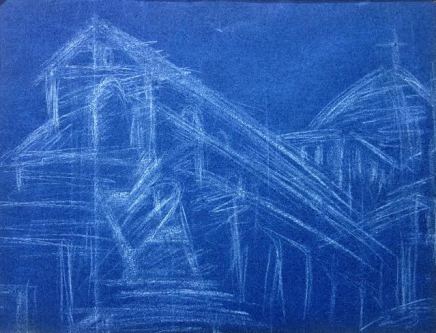
May 2014
THAI FUTURISM: Rethinking the “Modern” in Thai Modern Art History
Inspired, in part, by the exhibition ITALIAN FUTURISM, 1909–1944: Reconstructing the Universe, at the Solomon R. Guggenheim Museum, New York (21 February–1 September 2014), THAI ART ARCHIVES has launched THAI FUTURISM as an open-ended investigation into how the art-historical category of Futurism might inform new readings of the early modern period in Thai art history (roughly 1932–1962).
In what ways were Thai artists’ study of modern art movements and “isms”—Impressionism, Art Nouveau, Futurism, Cubism, Surrealism, Futurism, Constructivism, Art Deco, and others—“futurist” in ideology, visual topology, political and cultural identity construction, and utilitarian practice? How might a “futurist” topology in modern art from Europe and the United States inform the ways we reconsider modern Thai art developments, and the Thai nation’s engagement with “Western” forms and philosophies in the modern era? Can Futurism, as a category borrowed from trans-Atlantic currents in recent art history, be a useful tool for rethinking the developments of art in the Thai context since the early 1930s? What familiar and unfamiliar actors and cultural agents in this history might be reconsidered for their influence, contributions, and stated missions? What new perspectives may (or may not) be opened up on the art of Thailand of the early- to mid-twentieth century?
Drawing on the Guggenheim’s new resources and scholarship, as well as a host of sources in Thailand itself, this project will seek to shed new light on the recent past, as well as its lasting influence and points of connection to the contemporary context.
The project launch in August 2014 will be spearheaded in Bangkok by TAA Global Research Associate PAT KOLYOUTHAPONG, and intern PAPHOP (Graph) KERDSUP, with the collaboration of 333 GALLERY and KHUN TIRA VANICHTHEERANONT, owner of the FUA HARIPITAK ARCHIVES, Bangkok. (All interested parties should contact TAA director Gregory Galligan at thaiartarchives@gmail.com.)
We extend special thanks to curator VIVIEN GREENE, of the Solomon R. Guggenheim Museum, for her interest in this project, and her donation of one catalog from her exhibition ITALIAN FUTURISM to TAA’s special research library. We will consider presenting our research in the form of a publication, symposium, and exhibition, at its conclusion.
[Photo: Fua Haripitak, Piazza San Lorenzo, Florence, 1956; Fua Haripitak Archives, 333 Gallery, Bangkok; image by kind courtesy of the Estate of Fua Haripitak and 333 Gallery; All rights reserved.]
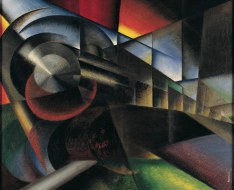
Ivo Pannaggi, Speeding Train, 1922
SOLOMON R. GUGGENHEIM MUSEUM, New York:
"Following World War I, Futurism gained new members and assumed different formal qualities, including those of arte meccanica (machine aesthetics). While mechanized figures and forms had appeared earlier (in the art of Fortunato Depero, for example), Ivo Pannaggi and Vinicio Paladini articulated the principles of this idiom in their 1922 “Manifesto of Futurist Mechanical Art.” Enrico Prampolini also adopted a mechanical language at this time, and he subsequently expanded and signed the manifesto, publishing it in his journal Noi in 1923.
Pannaggi’s Speeding Train (1922) demonstrates the Futurists’ sustained interest in the locomotive as a symbol of modernity, motion, and the machine. The painting depicts a powerful train barreling toward the viewer at a diagonal angle.Speeding Train suggests the total sensory experience of observing the daily trains passing through the small coastal towns along the Adriatic (the blur of the moving cars, the clamorous noise of the motor, the ear-splitting scream of the whistle).
Later, Pannaggi’s interest in machine aesthetics led him to integrate Constructivist elements such as beams, cubes, cylinders, and three-dimensional letters into his work. In 1932–33 he attended the Bauhaus in Germany, the only Futurist aside from Nicolaj Diulgheroff to do so."
See: http://exhibitions.guggenheim.org/futurism/arte_meccanica/
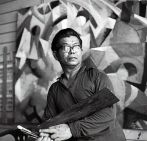
MODERN(ISM)S: Fua Haripitak Project
Updated April 2014
Thai Art Archives aims not only to document the progressive contemporary art of Thailand, but important ancestors of the modern and contemporary Thai art world. Foremost among them is FUA HARIPITAK (1910–1993; aka "Haribhitak"), Thailand's star pupil from the studio of Silpa Bhirasri (Corrado Feroci); reknowned professor (Silpakorn University); Thailand's 1st National Artist (1985); and pioneering conservationist of Thai mural painting.
Few observers are aware that the personal archives of Aj. Fua Haripitak—including personal papers, documents, diaries, sketchbooks, annotated books, and drawings—survive in the collections of 333 Gallery, Bangkok, after they were acquired by owner Tira Vanichtheeranont several years ago. Thai Art Archives and 333 Gallery are collaborating to catalog, study, and exhibit these archives (including little-known art works) for the public record.
—An important preliminary glimpse of this material will be made available to the public in a special 1st Anniversary exhibition of the Gallery in late April 2014; opening 27 April. (Please check our Facebook page for frequent updates.)—
By special collaboration with 333 Gallery, Bangkok, and the Estate of Aj. Fua Haripitak
[Photo: Uab Sanasen, Fua Haripitak, ca. 1950s; by kind courtesy of the Estate of Uab Sanasen, All rights reserved.]
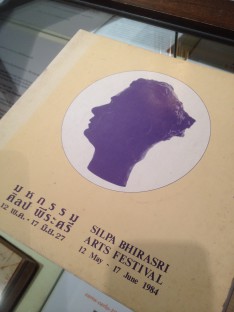
BHIRASRI INSTITUTE OF MODERN ART (BIMA), 1974-1988
The Bhirasri Institute of Modern Art (BIMA) was one of the most important and influential non-profit art venues in Bangkok from 1974 to 1988. This was a crucial decade for the development of Thai art in increasingly independent and progressive directions away from American and European “isms” that had held sway in Thai art academies (such as Silpakorn University) from the 1950s through the late 1970s. Supported primarily by Princess Pantip Paribatra Chumbhot (d. 1987), as well as artists, corporations, and others, BIMA rapidly became a rallying point for some of the most experimental and avant-garde exhibitions, thus acting as a bridge between Thailand’s earliest introduction to modernism by the example of its honorary spiritual namesake, Silpa Bhirasri (Corrado Feroci), and the increasingly independent and artist-directed scene of the late 1990s to the present.
Since its founding in 2010, Thai Art Archives has been in extended conversation, with BIMA’s most dynamic and long-serving director, Chatvichai Promadhattavedi (also former director of the Bangkok Art and Culture Centre) to arrange for the detailed chronicling of BIMA’s history, as well as the recovery and cataloging of primary materials, including photography, film, printed matter, and exhibition catalogs. The current literature on BIMA consists of brief discussion in general art history texts, such as Apinan Poshyananda’s Modern Art in Thailand, and Gridthiya Gaweewong’s An Alternative Space for the Arts: Assessing the Feasibility (M.A. Thesis, School of the Art Institute of Chicago, 1996). Additional textual documentation exists in the form of a brochure chronicling BIMA’s exhibition history, provided by Khun Chatvichai and available to the public at the TAA’s special projects hub (Bangkok Art and Culture Centre). In the near future, TAA will hope to recover artists’ documentation and oral histories, and digitize photography for public access. Stay tuned for new developments in the months ahead!
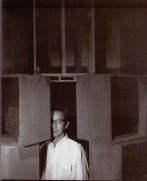
MONTIEN BOONMA ARCHIVES
Updated April 2014
[Montien Boonma]: Unbuilt/Rare Works (2013) celebrates the profound influence of Montien Boonma on current and future generations. The show brings to light some 60 original drawings rarely, or never before seen by the public, and newly uncovered archival ephemera, such as documents, notebooks, sketchbooks, printed matter, photographs, video footage, and related materials that have recently come to light through the collaboration of the Jim Thompson Art Center, the Thai Art Archives, and the Estate of Montien Boonma. The exhibition will be complemented by a program of guided tours and educational programs; in addition, this exhibition will feature an educational conference and a scholarly catalogue.
[Montien Boonma] is, in part, one of several culminating events of the Thai Art Archives’s “Montien Boonma Project,” first launched in 2010 with the aid of 150,000 THB provided by the James H. W. Thompson Foundation for facilitating new research and locate formerly lost or unknown archival ephemera—a goal recently aided by the generous cooperation of the Estate of Montien Boonma. The Project continues to the present and will seek to catalog and further study new materiaals of the artist discovered during the course of preparing the exhibition 0f 2013 (pending further funding).
[Photo: Manit Sriwanichpoom, Montien Boonma, 1997; by kind courtesy of the artist, All rights reserved.]











